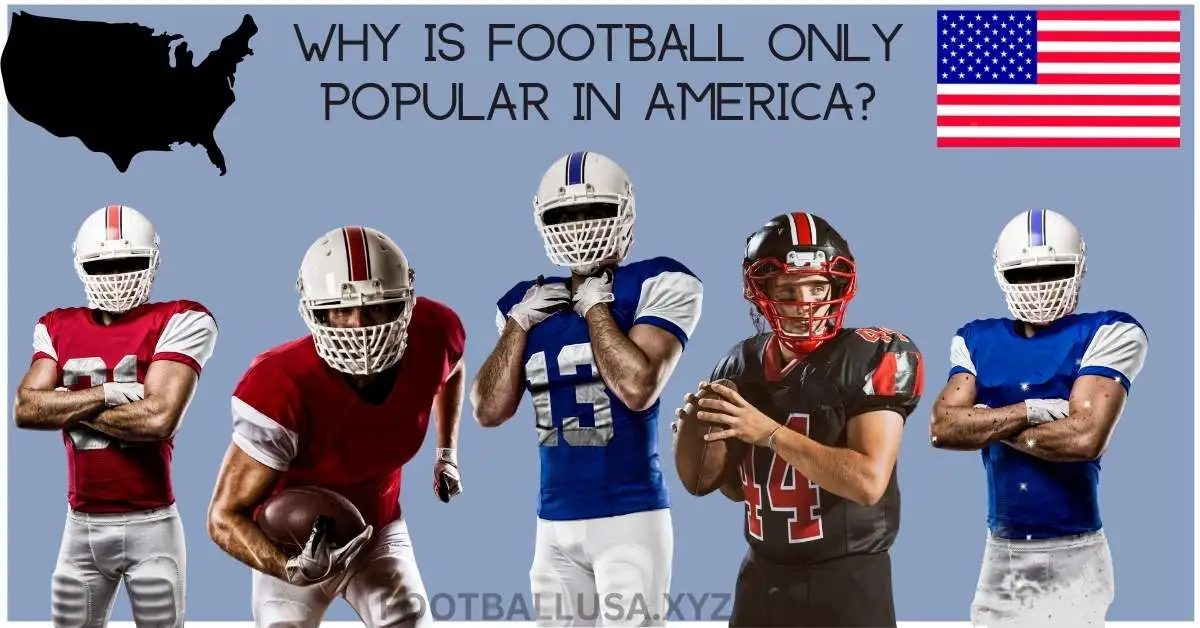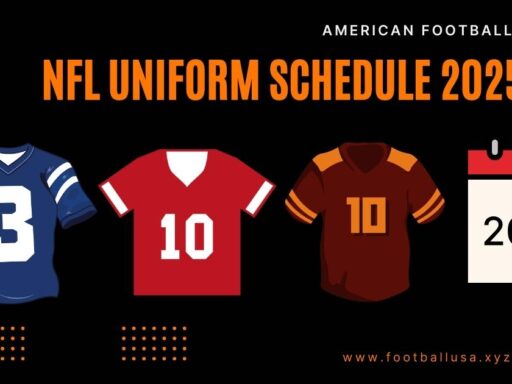American football is a sport deeply ingrained in American culture for decades. The National Football League (NFL) is the most-watched professional sports league in the United States, with an average of 16.5 million viewers per game during the 2019 season.
However, despite its immense popularity in America, American football remains relatively unknown and unappreciated in other parts of the world.
The purpose of this article is to explore why American football is only popular in America and not as widely embraced globally like other popular sports, such as soccer, basketball, or tennis.
We will examine the history of American football, cultural factors that contribute to its popularity in America, and potential
How Does American Football Compare with Global Sports Culture?
History and Evolution of American Football
American football has its origins in various forms of rugby and soccer played in Europe during the 1800s. British immigrants introduced the game to Americans. They played a modified version of rugby at Harvard University in the mid-19th century. Over time, American football evolved into its own distinct sport with unique rules and strategies.
By the early 1900s, professional teams began forming across America, leading to the creation of the NFL in 1920. Since then, American football has become deeply intertwined with American culture, from high school and college games on Friday nights and Saturdays to professional games on Sundays.
Differences between American Football and Other Popular Sports
While American football has some similarities to sports like rugby and soccer, there are also significant differences that may contribute to its lack of global appeal.
For one, American football is a highly physical sport with a focus on tackling and collisions between players. This level of aggression may not be as widely accepted or appreciated in other cultures.
Additionally, the stop-start nature of American football, with frequent breaks between plays, may not be as exciting for viewers accustomed to the continuous flow of action in sports like soccer.
Cultural Factors Influencing Popularity
American football’s popularity in America can also be attributed to various cultural factors unique to the country. The deep-rooted tradition of high school and college football, where thousands of fans gather to support their local teams, creates a strong sense of community and loyalty to the sport.
Furthermore, the commercialization of American football has made it a multi-billion dollar industry in America, with big-name sponsors and highly paid players. This level of financial investment and media coverage may not be as prevalent in other countries for American football to gain popularity.
Factors Behind American Football’s Popularity in the U.S.
National Identity and Pride
One significant factor behind American football’s popularity in the U.S. is its role in strengthening national identity and pride. The sport has become synonymous with American culture, and fans often see it as a representation of their country’s strength and values.
Strategic Marketing and Branding
The NFL has also been successful in strategically marketing and branding the sport to appeal to American audiences. From creating memorable halftime shows during the Super Bowl to featuring famous celebrity endorsements, these efforts have helped make American football a household name in America.
Limited Global Adoption of American Football
Challenges in Introducing the Sport to Other Countries
Despite efforts to expand globally, American football continues to face challenges in gaining widespread adoption. These include cultural differences, lack of infrastructure and resources, and limited media coverage for American football.
Adaptations and Variations in Other Countries
To overcome these challenges, adaptations and variations of American football have been created in other countries. For example, flag football eliminates the physical contact aspect of the sport, making it more appealing for some cultures.
Additionally, leagues such as the European League of Football and Japan X Bowl have been established to promote American football in their respective regions.
Growing Popularity in Some Countries
In recent years, there has been a noticeable increase in American football popularity in certain countries, driven largely by strategic initiatives and a growing fan base eager for diverse sporting experiences. For instance, European countries, including Germany and the United Kingdom, have shown keen interest in the sport.
The NFL’s strategy of hosting international games in iconic stadiums outside the U.S., such as London’s Wembley Stadium, has played a significant role in raising awareness and excitement for American football in these regions.
Moreover, television broadcasts and online streaming services have made NFL games more accessible to international audiences, allowing enthusiasts to follow the sport closely. Countries like Mexico and Brazil have also seen a rise in fan engagement, with millions tuning in to watch major events like the Super Bowl.

Youth development programs and grassroots initiatives are being implemented to nurture local talent and establish a foundational presence for the sport. With these efforts, American football is beginning to carve out a niche on the global sports stage, promising further integration and popularity in the years to come.
Potential for Expansion and Challenges
Opportunities for Growth and Expansion
The global sports market is constantly evolving, with new opportunities emerging every day. American football’s potential for expansion lies in its ability to adapt and cater to different cultures while maintaining its core principles. With an estimated 390 million people participating in the sport worldwide, there is immense potential for growth beyond America’s borders.
Moreover, the NFL’s commitment to promoting diversity and inclusivity within the sport has opened up opportunities for women and minorities to participate at both amateur and professional levels. This progress not only contributes to the sport’s appeal globally, but also paves the way towards a more diverse and inclusive sports industry.
Challenges in Expanding Beyond Borders
Despite these opportunities, challenges remain in expanding American football’s reach. These include, high costs to start and maintain a team, a lack of training and playing infrastructure, and low fan interest in the sport.
Cultural barriers may also hinder the sport’s penetration into some countries. The physical nature of American football may not align with certain cultures’ values or preferences for non-contact sports.
Moreover, government regulations and policies may pose challenges to establishing professional leagues or hosting international games in some regions.
Key Obstacles to Overcome
To successfully globalize American football, several key obstacles must be addressed. Firstly, the lack of understanding and familiarity with the game in many regions needs to be tackled through education and awareness campaigns.
Initiatives like international youth clinics and coaching programs can help demystify the sport’s rules and strategies for newcomers. Secondly, building infrastructure is crucial. Many countries lack the stadiums and training facilities to support the sport’s growth, requiring significant investment to develop these resources.
Furthermore, collaboration with local sports organizations can facilitate the exchange of expertise and resources, enhancing the sport’s integration into local sports ecosystems. Lastly, we must consider culture. We should promote versions of the sport that resonate with local preferences, such as non-contact variants.
By addressing these challenges, American football can continue to expand its international presence and capture the interest of sports fans worldwide.
Conclusion
In conclusion, while American football faces significant challenges in gaining a strong foothold on the global stage, there is no denying its potential for growth and expansion.
Through continued strategic initiatives by the NFL, such as hosting international games and fostering grassroots programs, the sport has shown its ability to capture the interest of diverse audiences.
By addressing cultural differences and logistical hurdles, American football can pave the way for increased global acceptance. Furthermore, the sport’s ability to evolve and incorporate new audiences reflects its adaptability and potential resilience.
As the world becomes increasingly interconnected, American football may become a cherished addition to the global sporting landscape, offering exciting possibilities and enriching the cultural tapestry of sports worldwide.
FAQ
What is the origin of American football?
American football originated in the United States in the late 19th century, evolving from rugby and soccer. It gained popularity through college sports, particularly in Ivy League schools, and gradually developed into a national sport.
Why is football only popular in America?
American football is popular in the U.S. due to its college roots, strong media presence, and a prominent professional league (NFL). Its complexity and physicality limit its appeal internationally compared to simpler sports like soccer.
Why didn’t American football spread globally like soccer?
Unlike soccer, American football was largely confined to U.S. schools and colleges, and didn’t spread internationally through colonization or global sports organizations. Soccer, with its simpler rules and lower equipment costs, gained widespread popularity, while American football remained mostly a U.S. phenomenon.
How has the U.S. education system influenced football’s popularity?
The U.S. education system, especially at the college level, promotes American football through large-scale competitions and scholarships. College football is a massive industry, generating millions in revenue and building a strong fan base that continues into professional football.
Is American football played in other countries?
Yes, American football is played in other countries, but it has a smaller following compared to sports like soccer or basketball. Some countries, like Canada and Japan, have professional leagues, but the sport doesn’t attract the same widespread attention as in the U.S.
How has the media contributed to American football’s popularity?
American football’s success is closely tied to television and media deals. The NFL, with its massive broadcasting contracts, has become a dominant force in U.S. sports entertainment. The Super Bowl is one of the most-watched sporting events in the world, further cementing football’s presence in American culture.
Why do other countries prefer soccer over American football?
Soccer’s global popularity stems from its accessibility, simplicity, and historical roots in many cultures. It requires minimal equipment, can be played anywhere, and has a strong international governing body (FIFA) that promotes the sport worldwide, making it more appealing to other countries.
Does the physicality of American football limit its global appeal?
American football is a highly physical sport, with significant contact and injury risks, which may discourage its adoption in countries where less violent sports are preferred. The need for protective gear and specialized training also makes it less accessible than sports like soccer or basketball.
Could American football ever become as popular internationally as it is in the U.S.?
While American football has grown in some countries, it faces significant challenges in achieving global popularity. The dominance of other sports like soccer, cultural differences, and the sport’s complexity make widespread international adoption unlikely in the near future.





